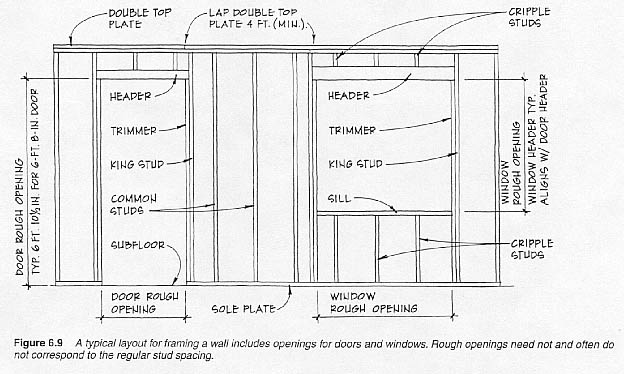Framing Glossary

- Bottom Plate
- The bottom, horizontal structural member
of a stud framed wall. The bottom plate sets on the subfloor, nails
through the subfloor into floor joists.
- Bridging
- Small pieces of wood or metal strapping
placed in an X-pattern between the floor joists at midspan to prevent
the joists from twisting and squeaking.
- Cap Plate
- The upper top plate.
- Compound Miter
- A miter (angle) cut with the saw blade
sloped at a specified angle (i.e. 22°, 45°).
- Corner Braces
- Diagonal braces placed at the corners of
framed walls to stiffen them and provide extra strength.
- Corner Post
- The wall stud and spacer blocks that create
an interior nailing surface for drywall at a framed corner.
- Cripple Stud
- Short studs placed between the header and
a top plate or between a sill and sole plate.
- Crown
- The upward bow, curve or rise along the
length of a board. Deck boards are set on end with the crown up. Over
time, the crown will sag and the board will straighten.
- Decking
- Usually referring to outside projects,
the lumber that forms the floor surface. Decking fastens directly over
the floor joists.
- Girder
- A larger beam of wood or steel used as
the principle support of concentrated loads at points along its span.
- Face-nail
- Driving a nail perpendicularly through
the width side board (i.e. straight, 90-degree angle)
- Fascia
- The visible flat front board that caps
the rafter tail ends and fly rafter edges.
- Floor Joists
- The main subfloor framing members that
support the floor span. Joist are usually made of engineered wood I-beams
or 2x8 (or larger) lumber.
- Fly Rafters
- The end rafters that form the outside edge
of the roof's rake (overhang).
- Header
- A beam placed perpendicular to wall suds
above doors, windows or other openings to carry the weight of structural
loads.
- Joist
- Parallel framing member installed horizontally
to support floor and ceiling loads.
- Joist Hangers
- Metal brackets designed to hold joist ends.
Using hangers is usually faster and easier than toenailing joists.
- Ledger Board/Strip
- A strip of lumber nailed to a beam, girder,
or rim joist on which the floor joists rest for support.
- Load-bearing Wall
- A wall that supports structural weight
above it. Identified by having overlapped or butted ceiling joists running
perpendicularly above it.
- Lookouts
- Rake cross-bracing between the fly rafters
and end gable rafters that the soffit nails to.
- Miter
- An angled cut, usually 45°. Unlike
a compound miter cut, the saw blade remains straight at 0°.
- Non Load-Bearing Wall
- A wall that supports no load other than
its own weight.
- On Center (O.C.)
- The term used to define the measured spacing
between studs, joists, rafters, etc. O.C. measurements are taken from
the center of one member to the center of the adjoining member.
- Penny
- A term applied to nails that originally
meant the price per hundred. Today, it indicates nail length and is
abbreviated with the letter "d," the English sign for one cent.
- Plumb
- The term used to define a vertical element
that is perfectly perpendicular to a level surface above or below.
- Plywood
- A piece of wood made of three or more layers
of wood veneer laminated together with glue.
- Pitch
- The angle of the roof slope, measured as
"X" inches per 12" (x/12). Roof pitches commonly range from 4/12 to
8/12. To calculate a roof's pitch, place a carpenter's level positioned
level on roof line, measure out 12" on the level, from that 12" point
measure down to the roof line. This figure (i.e. 4" to 8") is the first
number of the pitch.
- Rough Opening
- The framed-in opening, slightly larger
than the actual window/door, that replaces wall studs to support the
structure and accommodate a window/door.
- Sheathing
- The structural covering applied over studs,
rafters or roof trusses.
- Sill
- The piece of structural wood forming the
lower side of a window opening.
- Sill Plate
- The horizontal wood member that is anchored
to the foundation masonry to provide a nailing surface for floors or
walls built above.
- Soffit
- The underside board of eaves and rakes.
Soffits are often vented to draw air into the attic.
- Sole Plate
- The bottom horizontal structural member
of a stud framed wall.
- Spacer Blocks
- Short 2x4 or 2x6 blocks nailed to corner
studs. A wall stud is nailed to the spacers that creates a new nailing
surface.
- Span
- The distance between the structural supports
in floors, ceilings and roofs.
- Stick-Building
- Assembling framing one member at a time
on the job site, instead of raising prefabricating walls or trusses
as a unit.
- Stud
- A 2x4 or 2x6 vertical framing member used
to construct walls and partitions.
- Subfloor
- Boards or plywood installed over joists
on which the finish floor is laid.
- Tack
- A temporary nailer. An object it "tacked"
into place to assist in positioning, measuring, handling, etc.
- Toenailing
- Starting a nail at an angle or slant in
one framing member and driving it through into a second (usually perpendicular)
framing piece.
- Top Plate
- The top horizontal framing members of a
framed wall.
- Valley
- The inward angle of two sloping roof sections.
Framing consists of a doubled valley rafter in the middle that extends
from a top plate corner to a second ridge board, with angled jack rafters
for support.
|
